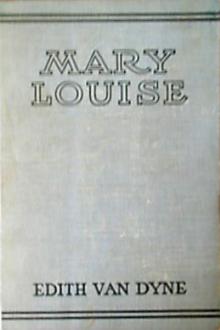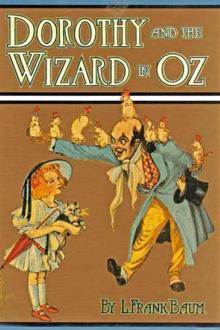Mary Louise, Lyman Frank Baum [read book .txt] 📗

- Author: Lyman Frank Baum
- Performer: -
Book online «Mary Louise, Lyman Frank Baum [read book .txt] 📗». Author Lyman Frank Baum
The Project Gutenberg EBook of Mary Louise, by Edith van Dyne
Copyright laws are changing all over the world. Be sure to check the copyright laws for your country before downloading or redistributing this or any other Project Gutenberg eBook.
This header should be the first thing seen when viewing this Project Gutenberg file. Please do not remove it. Do not change or edit the header without written permission.
Please read the “legal small print,” and other information about the eBook and Project Gutenberg at the bottom of this file. Included is important information about your specific rights and restrictions in how the file may be used. You can also find out about how to make a donation to Project Gutenberg, and how to get involved.
**Welcome To The World of Free Plain Vanilla Electronic Texts**
**eBooks Readable By Both Humans and By Computers, Since 1971**
*****These eBooks Were Prepared By Thousands of Volunteers!*****
Title: Mary Louise
Author: Edith van Dyne (one of L. Frank Baum’s pen names)
Release Date: May, 2004 [EBook #5660] [Yes, we are more than one year ahead of schedule] [This file was first posted on August 5, 2002] [Most recently updated August 31, 2002]
Edition: 10
Language: English
Character set encoding: ASCII
*** START OF THE PROJECT GUTENBERG EBOOK, MARY LOUISE ***
This eBook was produced by Juliet Sutherland, Charles Franks and the Online Distributed Proofreading Team.
MARY LOUISE
By
Edith Van Dyne
Author of “Aunt Jane’s Nieces Series” “The Daring Twins,” etc.
TO YOUNG READERS
You will like Mary Louise because she is so much like yourself. Mrs. Van Dyne has succeeded in finding a very human girl for her heroine; Mary Louise is really not a fiction character at all. Perhaps you know the author through her “Aunt Jane’s Nieces” stories; then you don’t need to be told that you will want to read all the volumes that will be written about lovable Mary Louise. Mrs. Van Dyne is recognized as one of the most interesting writers for girls to-day. Her success is largely due to the fact that she does not write DOWN to her young readers; she realizes that the girl of to-day does not have to be babied, and that her quick mind is able to appreciate stories that are as well planned and cleverly told as adult fiction.
That is the theory behind “The Bluebird Books.” If you are the girl who likes books of individuality—wholesome without being tiresome, and full of action without being sensational—then you are just the girl for whom the series is being written. “Mary Louise” is more than a worthy successor to the “Aunt Jane’s Nieces Series”—it has merit which you will quickly recognize.
THE PUBLISHERS.
CONTENTS
I JUST AN ARGUMENT
II GRAN’PA JIM
III A SURPRISE
IV SHIFTING SANDS
V OFFICIAL INVESTIGATION
VI UNDER A CLOUD
VII THE ESCAPE
VIII A FRIENDLY FOE
IX OFFICER O’GORMAN
X RATHER QUEER INDEED
XI MARY LOUISE MEETS IRENE
XII A CHEERFUL COMRADE
XIII BUB SUCCUMBS TO FORCE
XIV A CALL FROM AGATHA LORD
XV BUB’S HOBBY
XVI THE STOLEN BOOK
XVII THE HIRED GIRL
XVIII MARY LOUISE GROWS SUSPICIOUS
XIX AN ARTFUL CONFESSION
XX DIAMOND CUT DIAMOND
XXI BAD NEWS
XXII THE FOLKS AT BIGBEE’S
XXIII A KISS FROM JOSIE
XXIV FACING THE TRUTH
XXV SIMPLE JUSTICE
XXVI THE LETTER
“It’s positively cruel!” pouted Jennie Allen, one of a group of girls occupying a garden bench in the ample grounds of Miss Stearne’s School for Girls, at Beverly.
“It’s worse than that; it’s insulting,” declared Mable Westervelt, her big dark eyes flashing indignantly.
“Doesn’t it seem to reflect on our characters?” timidly asked Dorothy Knerr.
“Indeed it does!” asserted Sue Finley. “But here comes Mary Louise; let’s ask her opinion.”
“Phoo! Mary Louise is only a day scholar,” said Jennie. “The restriction doesn’t apply to her at all.”
“I’d like to hear what she says, anyhow,” remarked Dorothy. “Mary Louise has a way of untangling things, you know.”
“She’s rather too officious to suit me,” Mable Westervelt retorted, “and she’s younger than any of us. One would think, the way she poses as monitor at this second-rate, run-down boarding school, that Mary Louise Burrows made the world.”
“Oh, Mable! I’ve never known her to pose at all,” said Sue. “But, hush; she mustn’t overhear us and, besides, if we want her to intercede with Miss Stearne we must not offend her.”
The girl they were discussing came leisurely down a path, her books under one arm, the other hand holding a class paper which she examined in a cursory way as she walked. She wore a dark skirt and a simple shirtwaist, both quite modish and becoming, and her shoes were the admiration and envy of half the girls at the school. Dorothy Knerr used to say that “Mary Louise’s clothes always looked as if they grew on her,” but that may have been partially accounted for by the grace of her slim form and her unconscious but distinctive poise of bearing. Few people would describe Mary Louise Burrows as beautiful, while all would agree that she possessed charming manners. And she was fifteen—an age when many girls are both awkward and shy.
As she drew near to the group on the bench they ceased discussing Mary Louise but continued angrily to canvass their latest grievance.
“What do you think, Mary Louise,” demanded Jennie, as the girl paused before them, “of this latest outrage?”
“What outrage, Jen?” with a whimsical smile at their indignant faces.
“This latest decree of the tyrant Stearne. Didn’t you see it posted on the blackboard this morning? ‘The young ladies will hereafter refrain from leaving the school grounds after the hour of six p.m., unless written permission is first secured from the Principal. Any infraction of this rule will result in suspension or permanent dismissal.’ We’re determined not to stand for this rule a single minute. We intend to strike for our liberties.”
“Well,” said Mary Louise reflectively, “I’m not surprised. The wonder is that Miss Stearne hasn’t stopped your evening parades before now. This is a small school in a small town, where everyone knows everyone else; otherwise you’d have been guarded as jealously as if you were in a convent. Did you ever know or hear of any other private boarding school where the girls were allowed to go to town evenings, or whenever they pleased out of school hours?”
“Didn’t I tell you?” snapped Mable, addressing the group. “Mary Louise is always on the wrong side. Other schools are not criterions for this ramshackle establishment, anyhow. We have twelve boarders and four day scholars, and how Miss Stearne ever supports the place and herself on her income is an occult problem that the geometries can’t solve. She pays little Miss Dandler, her assistant, the wages of an ordinary housemaid; the furniture is old and shabby and the classrooms gloomy; the food is more nourishing than feastful and the tablecloths are so patched and darned that it’s a wonder they hold together.”
Mary Louise quietly seated herself upon the bench beside them.
“You’re looking on the seamy side, Mable,” she said with a smile, “and you’re not quite just to the school. I believe your parents sent you here because Miss Stearne is known to be a very competent teacher and her school has an excellent reputation of long standing. For twenty years this delightful old place, which was once General Barlow’s residence, has been a select school for young ladies of the best families. Gran’pa Jim says it’s an evidence of good breeding and respectability to have attended Miss Stearne’s school.”
“Well, what’s that got to do with this insulting order to stay in evenings?” demanded Sue Finley. “You’d better put all that rot you’re talking into a circular and mail it to the mothers of imbecile daughters. Miss Stearne has gone a step too far in her tyranny, as she’ll find out. We know well enough what it means. There’s no inducement for us to wander into that little tucked-up town of Beverly after dinner except to take in the picture show, which is our one innocent recreation. I’m sure we’ve always conducted ourselves most properly. This order simply means we must cut out the picture show and, if we permit it to stand, heaven only knows what we shall do to amuse ourselves.”
“We’ll do something worse, probably,” suggested Jennie.
“What’s your idea about it, Mary Louise?” asked Dorothy.
“Don’t be a prude,” warned Mable, glaring at the young girl. “Try to be honest and sensible—if you can—and give us your advice. Shall we disregard the order, and do as we please, or be namby-pambies and submit to the outrage? You’re a day scholar and may visit the picture shows as often as you like. Consider our position, cooped up here like a lot of chickens and refused the only harmless amusement the town affords.”
“Gran’pa Jim,” observed Mary Louise, musingly, “always advises me to look on both sides of a question before making up my mind, because every question has to have two sides or it couldn’t be argued. If Miss Stearne wishes to keep you away from the pictures, she has a reason for it; so let’s discover what the reason is.”
“To spoil any little fun we might have,” asserted Mable bitterly.
“No; I can’t believe that,” answered Mary Louise. “She isn’t unkindly, we all know, nor is she too strict with her girls. I’ve heard her remark that all her boarders are young ladies who can be trusted to conduct themselves properly on all occasions; and she’s right about that. We must look for her reason somewhere else and I think it’s in the pictures themselves.”
“As for that,” said Jennie, “I’ve seen Miss Stearne herself at the picture theatre twice within the last week.”
“Then that’s it; she doesn’t like the character of the pictures shown. I think, myself, girls, they’ve been rather rank lately.”
“What’s wrong with them?”
“I like pictures as well as you do,” said Mary Louise, “and Gran’pa Jim often takes me to see them. Tuesday night a man shot another in cold blood and the girl the murderer was in love with helped him to escape and married him. I felt like giving her a good shaking, didn’t you? She didn’t act like a real girl at all. And Thursday night the picture story told of a man with two wives and of divorces and disgraceful doings generally. Gran’pa Jim took me away before it was over and I was glad to go. Some of the pictures are fine and dandy, but as long as the man who runs the theatre mixes the horrid things with the decent ones—and we can’t know beforehand which is which—it’s really the safest plan to keep away from the place altogether. I’m sure that’s the position Miss Stearne takes, and we can’t blame her for it. If we do, it’s an evidence of laxness of morals in ourselves.”
The girls received this statement sullenly, yet they had no logical reply to controvert it. So Mary Louise, feeling that her explanation of the distasteful edict was not popular with her friends, quietly rose and sauntered to the gate, on her way home.
“Pah!” sneered Mable Westervelt, looking after the slim figure, “I’m always suspicious of those goody-goody creatures. Mark my words, girls: Mary Louise will fall from her pedestal some day.





Comments (0)